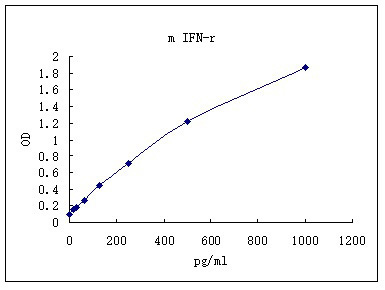Mouse IFN-gamma ELISA Kit (96-well)
CNY 3940.00
Specifications
| Product Data | |
| Description | Mouse IFN-gamma ELISA Kit (96-well) |
| Size | 1 x 96 wells |
| Format | 96-well strip plate |
| Assay Type | Solid Phase Sandwich ELISA |
| Assay Length | 3 hour |
| Signal | Colorimetric |
| Curve Range | 0.02 - 1.0 ng/mL |
| Sample Type | Cell culture supernatant, serum, plasma (EDTA, citrate, heparin) |
| Sample Volume | 20 uL |
| Specificity | Natural and recombinant Mouse IFN-? Ligand |
| Sensitivity | 7pg/mL |
| Reactivity | Mouse |
| Interference | No significant interference observed with available related molecules. |
| Components |
|
| Background | Interferon gamma (IFN-.) is a multifunctional protein first observed as an antiviral activity in cultures of Sindbis virus-infected human leukocytes stimulated by PHA . Produced by Tlymphocytes and natural killer (NK) cells, IFN-. ?is now known to be both an inhibitor of viral replication and a regulator of numerous immunological functions. Human IFN-.?is reported to be active only on human and non-human primate cells . The biochemistry and biological activities of the interferons have been extensively reviewed . Mouse IFN-. encodes a 155 amino acid (aa) residue precursor protein with a hydrophobic signal peptide that is cleaved to generate the 133 aa residue mature protein . In solution, IFN-. has been shown to exist as a non-covalently associated homodimer with topological similarity to IL-10. Mouse IFN-. shows approximately 40% aa sequence identity to human IFN-. and there is no cross-reactivity across species . A receptor for IFN-. ?has been identified and its gene localized to chromosome 6 Apparently the product of a single gene, the receptor is a single chain 90 kDa glycoprotein that shows a high degree of species-specific binding of IFN-.?. Functionally, IFN-. ?produces a variety of effects. Produced by CD8+, NK, gd,and TH1 T helper cells, IFN-. ?has documented antiviral, antiprotozoal and immunomodulatory effects on cell proliferation and apoptosis, as well as the stimulation and repression of a variety of genes he antiprotozoal activity of IFN-. ?against Toxoplasma and Chlamydia is believed to result from indoleamine 2,3-dioxygenase activity, an enzyme induced by IFN-. ?.The immunomodulatory effects of IFN-.? are extensive and diverse. In monocyte/macrophages, the activities of IFN-.?include: increasing the expression of class I and II MHC antigens; increasing the production of IL-1, platelet-activating factor, H2O2, and pterin; protection of monocytes against LAK cell-mediated lysis; downregulation of IL-8 mRNA expression that is upregulated by IL-2; and, with lipopolysaccharide, induction of NO production.Finally, IFN-.?has been shown to upregulate ICAM-1, but not E-Selectin or VCAM-1, expression on endothelial cells. |
| Gene Symbol | Ifng |
| Locus ID | 15978 |
| Standard Curve |

Representative standard curve for IFN-? ELISA. IFN-? was diluted in serial two-fold steps in Sample Diluent.
|
Documents
| Product Manuals |



